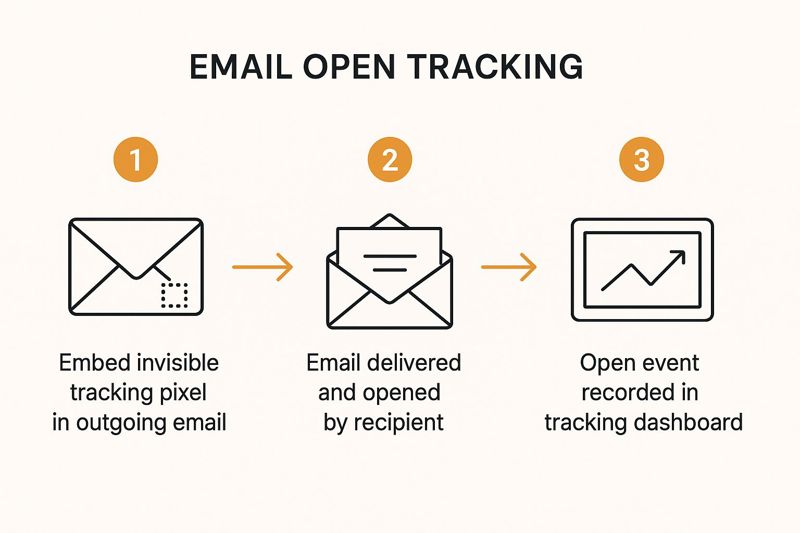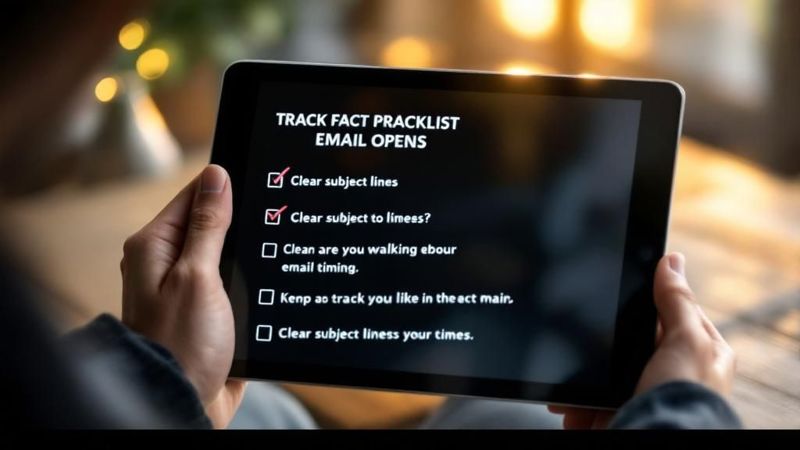The simplest way to track email opens is by embedding a tiny, invisible image—often just a single pixel—into your email's HTML. When your recipient opens the message, their email client sends a request to your server to load that image. That request gets logged, and just like that, you know they opened it.
It’s a simple trick, but it provides immediate feedback on how your campaign is landing.
Why Tracking Email Opens Still Matters

Before we get into the nuts and bolts, let's be clear: this isn't just a vanity metric. Knowing who opens your emails—and when—is like checking the pulse of your entire communication strategy. It’s the most direct feedback loop you have.
Think of your open rate as your audience's first impression. A high open rate means your subject line hit the mark, you nailed the timing, or you’ve built some serious brand trust. A low rate? That’s a clear signal that something’s off and needs a closer look.
A Quick Look at Email Tracking Methods
Here’s a simple breakdown of the main ways to track email opens, comparing how they work, what they're best for, and the skill level needed.
| Tracking Method | How It Works | Best Use Case | Technical Skill Needed |
|---|---|---|---|
| Tracking Pixel | A 1x1 invisible image embedded in email HTML. The server request logs the open. | Standard email marketing campaigns, newsletters, and automated sequences. | Low: Most email platforms handle this automatically. |
| SMTP Headers | Custom headers (like X-Report-Abuse-To) are added to the email. Some email clients send reports back. |
Advanced deliverability analysis and abuse monitoring. | High: Requires deep knowledge of email protocols and server configuration. |
| Third-Party Tools | Services like OKZest or ESPs (Mailchimp, HubSpot) handle the pixel embedding and reporting for you. | Anyone who wants reliable tracking without the manual setup. | Low to Medium: Varies from simple integration to API usage. |
Ultimately, the tracking pixel remains the most common and accessible method for most marketers and sales teams.
Gain Actionable Campaign Insights
Tracking opens isn't about stroking your ego; it's about making smarter decisions. The data you gather directly informs your next move. It helps you:
- Sharpen Your Subject Lines: A/B test different subject lines to see what style, tone, or length actually gets people to click.
- Optimize Send Times: Pinpoint the exact days and hours your audience is most likely to check their inbox.
- Segment Your Audience: Easily identify your most engaged subscribers and create special segments for them. On the flip side, you can isolate inactive users for a re-engagement push or simply clean them from your list.
For a sales team, this is gold. They can prioritize follow-ups with leads who have opened an email multiple times. A marketer might see opens dip in a certain segment and create a targeted campaign to win them back. With an estimated 376 billion emails flying around daily by 2025, you have to be strategic to cut through the noise.
By monitoring opens, you transform your email list from a static database into a dynamic map of audience interest. It’s the difference between shouting into the void and having a conversation.
Improve Deliverability and ROI
Continuously sending emails to people who never open them is a great way to wreck your sender reputation. Internet Service Providers (ISPs) pay attention to this lack of engagement and are more likely to start sending your emails straight to the spam folder.
By tracking opens, you can perform regular list hygiene—the process of removing inactive subscribers. This simple act dramatically improves your overall deliverability, making sure your messages land in front of the people who actually want them. When you connect these insights with powerful tools that use AI and automation to increase online sales, a simple open metric suddenly becomes a powerful driver for real revenue growth.
How Email Open Tracking Actually Works

Ever wondered what’s happening behind the scenes when you get that "email opened" notification? It might seem like digital magic, but it’s actually a surprisingly simple and clever trick. The most common method relies on something called a tracking pixel.
Think of it as a tiny, transparent image—just one pixel by one pixel (1x1)—tucked away in the email's HTML code. It's completely invisible to the naked eye and so small it has virtually no impact on loading times.
When your recipient opens the email, their client (like Gmail or Outlook) has to load all the content, including the images. In that instant, it sends a request to a server to fetch that invisible pixel. That single request is the signal. It acts as a digital tripwire, instantly logging that the email has been opened.
The Role of the Tracking Pixel
You don't need to be a developer to understand this; it's a core concept for any modern marketer. When that pixel is requested from the server, it doesn't just confirm an open. It can also scoop up some basic, non-personal data along the way.
- Timestamp: The exact time and date the email was viewed.
- Location: A general geographic area based on the recipient’s IP address.
- Device Type: Sometimes, it can tell if the email was opened on a desktop or a mobile device.
This humble pixel is the engine powering the dashboards in most email marketing platforms. It’s what feeds the open rate reports and engagement stats you use to see if your campaigns are actually hitting the mark.
The tracking pixel is essentially a silent messenger. It doesn’t interfere with the email's content but sends a crucial message back to you: "Someone is looking at this right now." This simple alert is the cornerstone of effective email engagement analysis.
Beyond the Basic Open Rate
While the pixel is the most popular way to track opens, it's not the whole story. Another layer of insight comes from tracked links.
When someone clicks a link in your email, they aren't sent directly to the final destination. Instead, they're momentarily redirected through a tracking service that logs the click before sending them on their way. An open tells you the subject line worked; a click confirms your content and call-to-action were compelling enough to act on.
Combining both gives you a much richer picture of engagement. And when used correctly, these tracked images can even be personalized for each person on your list—a powerful way to stand out. You can learn more by exploring different ways to use dynamic email marketing images in your campaigns. This blend of tracking pixels and engaging visuals elevates your outreach from a simple broadcast to an intelligent conversation.
A Practical Guide to Tracking Opens with OKZest
Okay, enough with the theory. Let's get our hands dirty and see how this works in the real world. While it's cool to know how a tracking pixel works, tools like OKZest do all the heavy lifting for you. This means you can get a powerful system to track email opening up and running without writing a single line of code. It’s all about creating a personalized, trackable image for each person you email.
This is much more than just a sneaky invisible pixel. When you personalize the image, you're actually adding a bit of value for the recipient while you gather the open data. Think about sending an event reminder with an image that says, "See you soon, John!" It’s a small touch, but it feels personal and engaging—and it doubles as your tracking mechanism.
Setting Up Your First Tracking Image
Getting started is surprisingly simple. Once you're logged into your OKZest dashboard, your first step is to create a new image template. This is your chance to get creative. You could design a banner, a simple graphic, or even a personalized certificate. The real magic happens when you add dynamic elements, like a merge tag for the recipient's first name, which automatically gets filled in for each person on your email list.
Here’s a quick look at the interface where you’ll set this up.

You can see you can also define fallback text (like "Valued Subscriber") for cases where you don't have a name. It’s a neat little feature that keeps your emails looking polished, no matter what.
Once you’ve designed your image, OKZest gives you a unique URL and a small snippet of HTML code. This is the code you'll pop directly into your email template. Your Email Service Provider (ESP) will then use its own merge tags to dynamically build a unique, personalized image for every single recipient.
Pro Tip: Don't feel like you need to create a masterpiece. I've found that even a simple, branded graphic with the person's name on it can make a big difference in engagement. The goal is to make the recipient feel seen, which turns a simple tracking tool into a genuine point of connection.
The entire process, from embedding the code to seeing the data roll in, is a straight shot. It really boils down to three core steps.
Embedding the Code into Your Email
With your HTML snippet copied, the last step is to paste it into your email builder. It doesn't matter if you're using Mailchimp, Klaviyo, HubSpot, or something else—they all have an option to add a custom HTML block.
Just drag an HTML block into your email where you want the image to show up and paste in the code from OKZest. When you hit send on your campaign, a few things happen behind the scenes:
- Personalization: Your ESP grabs the recipient’s data (like their name) and plugs it into the image URL.
- Image Generation: OKZest instantly creates the unique, personalized image just for that person.
- Tracking: When their email client loads that image, the open gets logged right into your analytics dashboard.
This approach gives you a much more sophisticated way to track email opening than a standard invisible pixel. You're combining practical data collection with a better user experience, giving you the insights you need while delivering more interesting content. It’s a true win-win that can seriously level up your email marketing.
Making Sense of Your Email Open Data

Once your tracking pixel is live, the data starts flowing in. But what does a 25% open rate really mean? Is it good? Bad? The honest answer is that the number itself is just one piece of a much larger puzzle, especially in today's privacy-focused world.
A huge factor currently skewing open-rate data is Apple's Mail Privacy Protection (MPP). Rolled out in iOS 15, this feature pre-fetches email content—including your tracking pixel—on Apple's servers. This triggers an "open" event whether the person ever actually saw your message or not.
Since so many people use Apple devices to check their email, this can seriously inflate your open rates, making them look much higher than they are. That's why you have to treat open rates as a directional signpost, not an absolute truth.
Navigating the Nuances of Modern Data
So, how do you get a real feel for engagement when the numbers might be fuzzy? Instead of getting hung up on the exact open rate of one campaign, it's smarter to shift your focus to broader patterns and other, more concrete metrics.
This means looking at trends over time. Is your open rate generally ticking upward month-over-month? Did that new subject line format you tried cause a noticeable spike compared to your last few emails? These relative changes are far more valuable than a single, isolated number.
Your goal isn't to chase a perfect open rate. It's to understand engagement trends. Look for patterns, not perfection. A sudden dip or a consistent rise in opens over a quarter tells you more than one campaign's stats ever could.
Combining Metrics for a Clearer Picture
The best way to measure real interest is to see what happens after the open. This is where combining metrics becomes essential for anyone serious about how they track email opening.
Here’s how you can build a more accurate view of what’s going on:
- Cross-Reference with Click-Through Rates: An open is passive, but a click is an active choice. If a campaign boasts a high open rate but a low click-through rate (CTR), MPP is likely inflating your numbers. A healthy CTR alongside a high open rate is a great sign of genuine interest.
- Monitor Reply Rates: For sales or any direct outreach, replies are the ultimate engagement metric. A prospect who opens and replies is clearly interested, which validates the open data for that specific person.
- Track Conversions: Did the email lead to a download, a sign-up, or a sale? Tying opens back to actual business results is the clearest indicator of an effective campaign.
By looking at these metrics together, you move from simply counting opens to truly understanding your audience's behavior. This multi-faceted approach gives you the context you need to make smart, data-informed decisions for your next email send.
Proven Strategies to Get More Emails Opened
Once you have a reliable way to track email opens, the real work begins. Knowing your numbers is the first step; improving them is what actually drives results. It’s time to move past the generic advice and focus on tactics that consistently convince people to open your messages.
It all starts with the subject line. This is your single biggest lever for boosting opens. Personalization here goes way beyond just using a name. Use dynamic tags to reference a recent purchase, a location, or an interaction they had with your brand. A subject line like "A special offer for our London customers" is far more compelling than a generic one.
Crafting an Irresistible First Impression
The subject line doesn't work in a vacuum. The preheader text—that small snippet of text visible next to the subject line in most inboxes—is your secret weapon. Don't let it default to "View this email in your browser." Use this valuable real estate to build intrigue and support your subject line.
For example:
- Subject: Your weekly design inspiration
- Preheader: Featuring hand-picked fonts and color palettes you'll love.
This combination tells a more complete story and gives subscribers a much better reason to click. Another powerful variable to test is the sender name. An email from "Jenna at OKZest" can feel much more personal and trustworthy than one from just "OKZest Team." It's definitely worth A/B testing to see what resonates with your audience.
Getting your emails opened is half the battle. Once you've captured their attention, the next challenge is to guide them toward a specific action. For a deeper dive into this, explore these effective strategies for improving click-through rates, which is the logical next step in optimizing your campaign performance.
Finding the Perfect Send Time and Cadence
Timing is everything. Sending an email at 2 AM on a Saturday probably won't yield great results for a B2B audience. Dive into your email platform's analytics to identify when your subscribers are most active. Don't just look at a single report; analyze trends over several campaigns to find your optimal send-time window.
Segmenting your audience is also crucial. A new subscriber might benefit from a welcome series sent over several days, while a long-time customer might only want to hear from you once a week. Tailoring your send frequency to different groups prevents list fatigue and keeps your engagement high.
While benchmarks can be helpful, your own data is always the best guide. The global average email open rate was around 21.5% in 2021, but this varied wildly by industry, from 28.5% in Education to just 17.1% in Retail. These numbers show how critical it is to focus on what works for your specific audience rather than chasing a generic standard.
By systematically testing and refining these core elements—subject lines, preheaders, sender names, and timing—you can build a powerful strategy for increasing engagement. For more actionable ideas, check out our comprehensive guide on how to increase email open rates with strategies that transform results.
Common Questions About Email Tracking
Once you start digging into email open tracking, a few questions always pop up. It's totally natural. Getting solid answers to these common concerns is the key to using this data with confidence. Let's walk through some of the most frequent questions we hear from marketers and sales teams.
Is Email Tracking Perfectly Accurate?
This is a big one. Can you trust your open rate data completely? The honest answer is no, it's not 100% accurate. It’s better to think of open tracking as a powerful directional tool for spotting trends, not as a source of perfectly absolute numbers.
A few things can throw the data off:
- Image Blocking: If someone's email client blocks images by default (a common setting), your tracking pixel never loads. That means their open goes completely unrecorded.
- Privacy Tools: As we covered, things like Apple’s Mail Privacy Protection can preload images in the background. This registers an "open" even if the user never actually laid eyes on your email.
Because of these variables, it’s much more useful to focus on the relative change in your open rates over time. Don't get hung up on the exact percentage of a single campaign. A consistent upward trend is a far better sign of success.
What Is a Good Email Open Rate?
Everyone wants to know the magic number for a "good" open rate, but the truth is, there isn't one. The right benchmark really depends on your industry, the health of your list, and what kind of email you're sending.
You'll see general averages thrown around, often between 20-40%, but these numbers are almost always inflated by the privacy tools we just talked about.
A much better approach is to benchmark against your own past performance. Just aim for steady improvement. Think about it: an email to a small, highly engaged list for a local nonprofit will naturally crush the open rate of a massive promotional blast from a big retail brand. The context is everything.
Is It Legal to Track Email Opens?
Another huge concern is legality. The short answer is yes, in most places, it is permissible.
Regulations like GDPR and the CAN-SPAM Act generally allow for email open tracking. It often falls under the umbrella of 'legitimate interest' for improving your service. The most important piece of the puzzle is transparency—your privacy policy needs to clearly state that you monitor email engagement.
Of course, staying compliant involves more than just tracking opens. To get the full picture, it's always smart to review guides on email deliverability best practices to make sure your entire strategy is on solid ground.
Ultimately, tracking works in most modern HTML email clients like Gmail, Outlook, and Apple Mail. But it won't function in plain-text emails, and as we've seen, its reliability can be hit-or-miss depending on user settings. Understanding these limitations is the first step to using open data intelligently to build a better email strategy.
Ready to move beyond basic tracking and create emails that truly connect? With OKZest, you can add personalized, dynamic images to every message, boosting engagement while gathering valuable insights. Start for free and see the difference today.